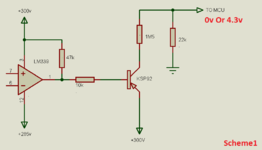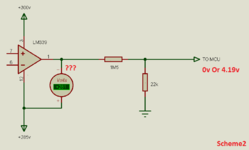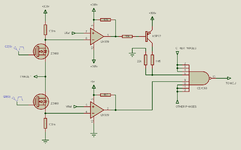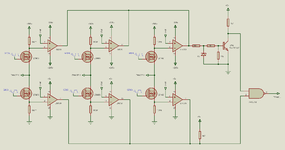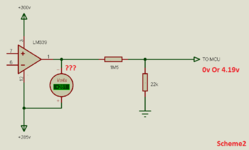tyilgin
Junior Member level 2
Hi all,
I am trying to detect High side current control with LM339.
I think I should use Scheme1 to reduce the comparator's output to the level of the mictocontroller.
However, since I use a lot of this process in my project, I'm thinking of using the Scheme2 style in order to both take up less space on the card and not have extra delays.
I am aware that the output of the LM339 in schematic 2 is not a pull-up resistor. I'm also undecided whether the absence of this resistor would be a downside for the LM339. Because it says in the datasheet that the output current should be Min.6mA, but while researching, I found many example schematics designed with 500uA (5v/10k). I'm a little confused about this too.
The LM339 datasheet says "Output voltage max.36v" but in my application it produces a voltage of around 281v.
Although there is a lower value (36v x 20mA=720mW == 281v x 0.3mA=85mW) in terms of power, unfortunately I am not educated enough to decide whether this usage will cause problems.
Can I have your opinion on this please
If it is not applicable, if it can be made usable with minor changes, I would be happy if you could help.
Thinking that I can benefit from the zener diode, I also thought of using a 270V zener diode in series with the 1M5 resistor in Scheme1, but I gave up because I could not find it in a small size.
I am trying to detect High side current control with LM339.
I think I should use Scheme1 to reduce the comparator's output to the level of the mictocontroller.
However, since I use a lot of this process in my project, I'm thinking of using the Scheme2 style in order to both take up less space on the card and not have extra delays.
I am aware that the output of the LM339 in schematic 2 is not a pull-up resistor. I'm also undecided whether the absence of this resistor would be a downside for the LM339. Because it says in the datasheet that the output current should be Min.6mA, but while researching, I found many example schematics designed with 500uA (5v/10k). I'm a little confused about this too.
The LM339 datasheet says "Output voltage max.36v" but in my application it produces a voltage of around 281v.
Although there is a lower value (36v x 20mA=720mW == 281v x 0.3mA=85mW) in terms of power, unfortunately I am not educated enough to decide whether this usage will cause problems.
Can I have your opinion on this please
If it is not applicable, if it can be made usable with minor changes, I would be happy if you could help.
Thinking that I can benefit from the zener diode, I also thought of using a 270V zener diode in series with the 1M5 resistor in Scheme1, but I gave up because I could not find it in a small size.
